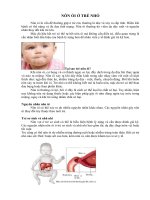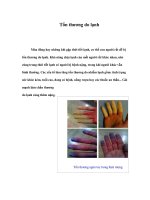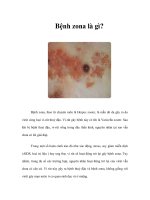Tài liệu Untreated Inactive Pulmonary Tuberculosis docx
Bạn đang xem bản rút gọn của tài liệu. Xem và tải ngay bản đầy đủ của tài liệu tại đây (1.43 MB, 10 trang )
Untreated
Inactive
Pulmonary
Tuberculosis
Risk
of
Reactivation
GEORGE
W.
COMSTOCK,
M.D.,
Dr.P.H.
THE
RELAPSING
TENDENCY
of
pul¬
monary
tuberculosis
is
widely
known
and
well
documented.
In
1938,
Puffer,
Stewart,
and
Gass
(1)
reported
from
the
Williamson
County
(Tenn.)
Tuberculosis
Study
that
12
percent
of
white
persons
classified
as
having
minimal
arrested
tuberculosis
and
15
percent
of
those
having
latent
apical
tuberculosis
had
be¬
come
worse
during
a
3-year
period
of
observa¬
tion.
Eeisner
and
Downes
(2)
investigated
the
relapse
rate
among
a
sample
of
persons
with
productive,
fibrotic,
or
calcific
minimal
tubercu¬
losis
who
attended
the
ambulatory
chest
clinics
of
the
New
York
City
Department
of
Health.
They
found
5
percent
of
whites
and
14
percent
of
nonwhites
had
developed
active
disease
in
5
years.
Among
a
group
of
upstate
New
York
patients,
diagnosed
by
the
staff
of
Hermann
M.
Biggs
Memorial
Hospital
between
1937
and
1947
as
having
minimal
arrested
tuberculosis,
the
risk
of
developing
active
tuberculosis
dur¬
ing
the
10
years
following
diagnosis
was
13
percent
(3).
Similar
studies
have
been
made
in
other
countries.
Kallquist
(^),
reporting
from
Swe¬
den
on
the
experience
of
312
persons
considered
to
have
inactive
or
probably
inactive
tubercu¬
losis,
noted
that
8
percent
had
shown
evidence
of
active
disease
within
a
period
of
8
years.
A
comprehensive
report
on
the
Danish
Tubercu¬
losis
Index
by
Groth-Petersen,
Knudsen,
and
Dr.
Comstock
is
with
the
Tuberculosis
Branch
of
the
Communicable
Disease
Center,
Public
Health
Service,
Washington,
D.C.
Wilbek
(5)
included
observations
on
560
per¬
sons
never
previously
reported
as
tuberculosis
cases
because
their
chest
roentgenograms
were
considered
to
show
fibrosis
only.
Within
4
years,
nearly
2
percent
had
developed
active
disease.
In
south
India,
Frimodt-M^ller
(6)
found
an
average
annual
reactivation
rate
of
6
percent
for
persons
classified
as
probably
having
inactive
tuberculosis
and
1
percent
for
those
initially
considered
to
have
clinically
in-
significant,
inactive
disease.
Although
the
foregoing
studies
have
indi¬
cated
considerable
variation
in
the
average
an¬
nual
reactivation
rate,
a
variation
that
could
be
related
both
to
differences
in
the
definitions
of
a
case
and
in
the
living
conditions
of
the
study
populations,
all
agreed
that
the
risk
of
reactivation
was
substantial.
And
yet
there
is
surprising
variation
in
the
period
of
observa¬
tion
recommended
for
persons
with
inactive
pulmonary
tuberculosis.
Some
health
depart¬
ments
do
not
advise
any
followup
of
persons
with
newly
diagnosed
minimal
inactive
disease;
others
advise
periodic
examinations
for 5
years
or
longer.
Such
variation
in
public
health
practice
suggested
the
need
for
further
infor¬
mation
on
the
importance
of
relapses
among
persons
with
inactive
disease
as
a
source
of
active
tuberculosis.
Information
gathered
by
the
Muscogee
County
Tuberculosis
Study
was
used
to
esti¬
mate
the
prognosis
of
untreated
inactive
pul¬
monary
tuberculosis.
The
discovery
and
pro¬
longed
observation
of
all
cases
of
tuberculosis
in
the
community
has
been
one
of
the
major
Vol.
77,
No.
6,
June
1962
461
goals
of
this
study
since
its
inception
in
1946
(7).
Consequently,
casefinding
activities
in
this
area
have
been
more
extensive
than
is
often
possible.
Communitywide
photofluorographic
surveys
were
conducted
in
1946
and
again
in
1950
(8$).
In
addition,
the
number
of
chest
X-ray
examinations
made
by
the
health
de¬
partment
each
year
approximated
one-sixth
of
the
total
population.
The
medical
profession
and
allied
agencies
in
the
community
have
been
highly
cooperative
in
reporting
tuberculosis
cases,
usually
relinquishing
responsibility
for
followup
supervision
to
the
study.
As
a
result,
it
is
believed
that
nearly
all
known
cases
have
been
reported
to
and
supervised
by
the
study.
All
persons
with
definite
or
suspected
tuber¬
culosis
were
advised
to
obtain
quarterly
or
semiannual
examinations
until
their
disease
had
shown
no
evidence
of
activity
for
at
least
5
years.
Although
routine
followup
was
then
discontinued,
subjects
were
advised
to
be
ex¬
amined
annually
and
were
sent
reminders
of
these
examinations
as
long
as
they
continued
to
live
in
the
area.
Facilities
for
sputum
exami¬
nations
have
also
been
readily
available,
with
cultures
for
mycobacteria
a
routine
part
of
the
examination
since
1947.
Sputum
specimens
were
requested
at
the
beginning
and
end
of
the
routine
followup
period,
and
also
whenever
clinical
or
roentgenographic
evidence
of
pos¬
sibly
active
disease
was
noted.
Almost
all
pa¬
tients
with
a
history
of
productive
cough
complied
with
the
requests
for
specimens.
Many,
however,
denied
this
symptom
and
failed
to
submit
specimens.
Gastric
lavages
were
rarely
performed.
Initial
Study
Population
The
population
from
which
the
cases
of
un¬
treated
inactive
pulmonary
tuberculosis
were
drawn
comprises
all
persons
who
were
first
reported
to
the
Muscogee
County
Tuberculosis
Study
as
having
definite
or
suspected
tuber¬
culosis
between
January
1,1946,
and
January
1,
1956,
and
who
also
met
the
following
criteria:
(a)
at
the
time
these
persons
were
reported,
they
lived
in
Muscogee
County,
and
were
15-65
years
of
age;
(b)
before
being
reported,
they
had
never
been
advised
to
be
hospitalized
for
tuberculosis;
(c)
2
years
after
the
first
report,
Table
1.
Year
in
which
members
of
initial
study
population
were
reported
to
the
Muscogee
County
Tuberculosis
Study
as
tuberculosis
cases
or
suspects
they
were
still
registered
as
having
suspected
or
definite
pulmonary
tuberculosis
and
were
not
known
to
have
extra-pulmonary
tuberculosis.
A
total
of
1,327
persons
met
these
criteria.
The
year
in
which
they
were
first
reported
to
the
study
is
shown
in
table
1.
More
than
one-
third
were
detected
in
1946,
the
year
of
the
first
community
survey.
One-sixth
came
to
atten¬
tion
in
1950,
largely
as
the
result
of
the
second
survey.
Although
the
proportion
discovered
in
each
of
the
other
years
has
been
quite
con¬
stant,
this
actually
reflects
a
decline
in
the
mor¬
bidity
rate
owing
to
the
increase
in
population
of
Muscogee
County,
Ga.,
from
95,638
persons
in
1946
to
158,623
in
1960.
The
composition
of
the
initial
study
popula¬
tion
and
the
type
of
examination
which
led
to
the
recognition
of
tuberculosis
are
shown
in
table
2.
Almost
70
percent
of
the
cases
were
in
whites
and
30
percent
in
Negroes.
However,
since
considerably
fewer
Negroes
than
whites
reside
in
the
county,
the
morbidity
rate
was
slightly
higher
among
Negroes.
Slightly
more
than
half
of
the
whites
but
only
one-third
of
the
Negroes
were
over
the
age
of
45
years.
A
much
higher
proportion
of
Negroes
than
whites
were
classified
as
having
advanced
disease,
44
percent
contrasted
with
23
percent.
For
both
races,
the
proportion
of
advanced
tuberculosis
was
larger
among
the
younger
age
groups.
Almost
half
of
the
group
was
brought
under
supervision
as
the
result
of
the
two
mass
sur¬
veys.
If
persons
detected
by
survey-like
pro¬
cedures
such
as
preemployment
and
foodhandler
462
Public
Health
Reports
examinations
are
also
included,
more
than
three-
fifths
were
found
among
presumably
healthy
groups.
Only
a
few
were
identified
because
they
had
been
in
contact
with
a
case
of
active
tuberculosis.
A
third
of
the
total
group
was
classified
as
symptomatic,
having
been
referred
for
examination
by
private
physicians
or
hos¬
pital
clinics
or
self-referred.
Many
contacts
were
in
the
category
of
symptomatic
referrals.
These
persons
had
no
evidence
of
tuberculosis
on
routine
contact
examinations,
but
returned
for
reexamination
when
symptoms
developed
rather
than
waiting
for
their
next
routine
fol¬
lowup
examination.
As
might
be
anticipated,
a
high
percentage
of
advanced
cases
came
from
the
group
of
symptomatic
referrals.
Although
older
persons
did
not
participate
well
in
the
community
surveys,
a
surprisingly
large
pro¬
portion
of
those
with
minimal
or
suspected
diseases
among
them
were
discovered
this
way.
Active
and
Inactive
Tuberculosis
Arriving
at
an
appropriate
definition
of
ac¬
tive
tuberculosis
was
not
as
simple
as
might
ap¬
pear
at
first
glance.
Primarily,
a
definition
was
desired
which
would
designate
persons
who
were
truly
ill
and
whose
tuberculosis
was
sufficiently
severe
to
require
a
major
change
in
their
lives.
It
did
not
seem
important
to
study
the
incidence
of
disease
manif
ested
only
by
isolated
demon¬
strations
of
acid-fast
bacilli
or
by
minor
roent-
genographic
changes.
No
single
criterion
seemed
adequate
to
des¬
ignate
significantly
active
tuberculosis.
Even
the
finding
of
acid-fast
bacilli
with
the
cultural
characteristics
of
Mycobacterium
tuberculosis
was
far
from
satisfactory.
In
this
part
of
the
world,
acid-fast
bacilli
have
been
isolated
with
considerable
frequency
from
certain
healthy
population
groups
(10).
Some
of
these
or¬
ganisms
could
have
been
mistaken
for
M.
tuber-
culosis,
particularly
in
the
earlier
days
of
the
study.
But
the
major
reason
for
not
accepting
this
single
criterion
was
the
fact
that
tubercle
bacilli
were
isolated
from
a
sizable
segment
of
this
study
group
on
only
a
single
occasion,
with
no
other
evidence
of
active
disease
on
prolonged
bacteriological
and
roentgenographic
observa¬
tion.
Although
one
widely
used
standard
would
automatically
classify
these
persons
as
having
active
tuberculosis
(ii),
their
disease
did
not
then
and
has
not
yet
shown
any
evidence
of
be¬
coming
a
real
health
problem.
The
use
of
roentgenographic
change
also
seemed
inadequate
as
the
only
criterion
for
ac¬
tive
disease,
particularly
in
view
of
the
demon¬
strated
difficulties
in
getting
agreement
even
among
experts
in
classifying
tuberculosis
from
chest
roentgenograms
(12,13).
And
again
there
Table
2.
Percentage
of
tuberculosis
cases
in
initial
study
population
discovered
by
specified
types
of
examination,
by
race,
stage
of
disease,
and
age
group
Vol.
77,
No.
6,
June
1962
463
were
a
number
of
persons
with
roentgeno¬
graphic
evidence
of
active
tuberculosis
but
with
no
other
evidence
of
active
disease
even
on
pro¬
longed
followup.
After
careful
consideration,
it
appeared
that
the
most
appropriate
weighting
of
the
various
diagnostic
factors
could
be
achieved
by
defining
the
onset
of
significantly
active
disease
as
the
time
when
hospital
treatment
was
first
recom¬
mended.
This
definition
had
several
advan¬
tages.
First
the
recommendation
for
hospital¬
ization
was
an
event
which
could
be
clearly
recognized
and
dated
from
the
records.
Most
important,
the
decision
to
recommend
hos¬
pitalization
indicated
the
recognition
of
a
sig¬
nificant
adverse
change
in
a
patient's
condition.
While
bacteriological
and
roentgenographic
findings
obviously
influenced
this
decision
much
more
than
any
other
factor,
the
use
of
clinical
judgment
manifested
in
the
rec¬
ommendation
for
hospital
treatment
appeared
to
be
the
most
satisfactory
method
of
discount-
ing
isolated
or
inconsistent
findings
which
might
otherwise
inflate
the
proportion
of
in-
significantly
active
cases.
Kecommendations
for
hospitalization
were
not
materially
affected
by
the
availability
of
hospital
beds
or
by
enthu-
siasm
for
ambulatory
treatment.
Throughout
the
period
of
this
study,
hospital
beds
were
available
with
little
or
no
delay
for
Muscogee
County
patients.
Furthermore,
hospital
treat¬
ment
was
almost
always
recommended
for
per¬
sons
believed
to
have
active
progressive
tuber¬
culosis,
only
a
few
exceptions
having
occurred
in
recent
years.
Inactive
tuberculosis
was
defined
as
the
ab¬
sence
of
significantly
active
tuberculosis
for
at
least
2
years
after
the
individual
was
reported
to
the
study
as
a
tuberculosis
case
or
suspect.
The
classification
of
the
1,327
persons
in
the
initial
study
population
2
years
after
they
had
first
been
reported
as
a
tuberculosis
case
or
suspect
is
shown
in
table
3.
In
this
period,
314
persons
were
thought
to
have
active
tuberculosis,
the
majority
within
a
few
weeks
of
initial
report.
Five
persons
without
evidence
of
active
disease
are
known
to
have
died
during
this
2-year
period;
the
remaining
1,008
comprise
the
inac¬
tive
cases
for
this
analysis.
The
majority
had
only
suspected
or
minimal
disease
initially.
Relatively
few
of
the
persons
with
inactive
dis¬
ease
had
advanced
tuberculosis
because
there
were
not
many
advanced
cases
in
the
initial
study
group.
Moreover,
70
percent
were
classi¬
fied
as
having
active
disease
before
2
years
had
elapsed.
Method
of
Analysis
The
analysis
includes
observations
on
all
per¬
sons
in
the
study
population
through
June
30,
Table
3.
Classification
of
study
population
2
years
after
initial
report
as
tuberculosis
case
or
sus¬
pect,
by
race,
initial
stage
of
disease,
and
age
group
464
Public
Health
Reports
1960,
with
the
total
period
of
observation
rang¬
ing
from
4^
to
ltyfa
years.
Because
2
years
had
to
elapse
before
a
person
could
be
classified
as
having
inactive
disease,
the
potential
range
of
observation
for
cases
of
inactive
tuberculosis
was
2%
to
12i/£
years.
Two
modifications
were
made
in
applying
the
life
table
method
of
analysis
to
the
findings
of
this
study.
The
first
modification
was
the
use
of
two
different
as-
sumptions
regarding
the
development
of
active
tuberculosis
among
persons
withdrawn
from
observation
because
they
moved
away
or
dis¬
continued
examination.
Assumption
1
is
that
the
development
of
active
disease
could
only
be
determined
during
the
period
in
which
the
subjects
were
under
observation.
The
period
of
observation
would
thereby
be
counted
from
the
date
of
report
to
the
date
of
last
examination
before
July
1,
1960.
This
assumption
under-
states
the
person-years
of
observation
and
thus
overestimates
the
risk
of
developing
active
disease.
Assumption
2
is
that
significant
reac¬
tivation
would
become
known
for
surviving
members
of
the
study
population
even
if
they
did
not
continue
to
be
examined
by
the
study,
and
that
their
experience
can
thus
be
counted
through
June
30,
1960.
This
assumption
is
based
on
the
probability
that
persons
develop¬
ing
significantly
active
tuberculosis
after
dis-
continuing
observation
would
seek
medical
care,
and
that
their
physicians
would
then
re¬
quest
their
previous
chest
roentgenograms.
In
this
way,
the
study
would
learn
that
reactiva¬
tion
had
occurred.
Assumption
2
overstates
the
person-years
of
observation,
mainly
be¬
cause
most
deaths
which
occurred
among
per¬
sons
who
moved
away
did
not
become
known
to
the
study.
It
probably
also
understates
the
number
of
reactivations.
On
both
counts,
as¬
sumption
2
tends
to
underestimate
the
risk
of
reactivation.
The
second
modification
of
the
usual
life
table
technique
was
to
apply
it
in
two
steps.
First,
the
standard
approach
was
used
in
the
analysis
of
the
findings
for
the
first
2
years
of
observa¬
tion.
For
those
who
passed
through
this
2-
year
period
without
having
active
tuberculosis
and
who
were
thereby
designated
as
having
inactive
tuberculosis,
the
calculation
of
time-
specific
and
cumulative
risks
was
again
under¬
taken,
with
the
beginning
of
the
third
year
as
the
starting
period.
Suspected
and
minimal
tuberculosis
were
combined
into
a
single
category
because
the
risk
was
essentially
the
same
for
both
of
them.
Moderately
and
far
advanced
tuberculosis
were
combined
because
of
the
small
numbers
in
each
group.
For
persons
with
advanced
tuberculosis,
so
few
survived
the
first
2
years
without
having
active
disease,
that
the
two
age
groups
had
to
be
combined;
even
so,
the
numbers
of
advanced
inactive
cases
are
small.
Results
The
bacteriological
and
roentgenographic
findings
for
the
1,008
persons
classified
as
hav¬
ing
inactive
tuberculosis
are
shown
in
table
4.
Of
the
68
for
whom
hospital
treatment
for
tuberculosis
was
recommended,
60
had
both
positive
bacteriological
and
roentgenographic
evidence
of
active
tuberculosis
at
some
time;
only
1
had
neither
of
these
two
criteria.
Of
the
940
persons
for
whom
hospital
treatment
was
never
recommended,
2
had
both
bacteriological
or
roentgenographic
evidence
of
active
disease.
Vol.
77,
No.
6,
June
1962
465
Cumulative
probability
of
reactivation
of
inactive
pulmonary
tuberculosis,
by
race,
age,
and
initial
stage
of
disease,
according
to
two
different
assumptions
(1
and
2)
regarding
followup
observations
WHITE
NEGRO
1
5-44
years
of
age
at
initial
report,
with
minimal
or
suspected
tuberculosis
2
years
later
.30r
.25
.20
.15
.10
.05
S
.00
4)
O
a
>
.35r
u
.30K
.25
.20
.15
.10
.05
.00
45-64
years
of
age
at
initial
report,
with
minimal
or
suspected
tuberculosis
2
years
later
1
5-64
years
of
age
at
initial
report,
with
advanced
tuberculosis
2
years
later
J_L
J_I
10
12
14
0
2
4
6
8
Years
after
initial
report
10
12
14
Note
:
Heavy
line
indicates
that
the
population
base
is
50
or
more
persons;
thin
line
indicates
that
the
base
is
20-50
persons.
466
Public
Health
Reports
The
use
of
positive
bacteriological
and
roent¬
genographic
findings
together
as
a
criterion
of
active
tuberculosis
would
have
altered
but
little
the
proportion
of
persons
classified
as
having
reactivated
disease.
Parenthetically,
it
may
be
noted
that
a
major
factor
in
the
dis¬
crepancy
between
positive
bacteriological
find¬
ings
and
the
roentgenographic
classification
of
active
tuberculosis
was
the
conscious
attempt
to
record
the
interpretations
of
chest
roent¬
genograms
without
regard
to
other
findings.
Had
these
interpretations
been
completely
independent,
it is
likely
that
disagreement
between
the
two
criteria
would
have
been
even
greater.
For
inactive
cases,
the
risk
of
developing
active
disease
is
shown
in
the
chart
for
each
of
the
two
assumptions
regarding
followup.
A
summary
of
the
risk
for
inactive
cases
from
the
third
through
the
seventh
years
of
observa¬
tion
appears
in
table
5.
Of
1,008
persons
who
had
not
developed
active
tuberculosis
in
the
first
2
years
of
observation,
68
were
considered
to
have
developed
active
disease,
53
of
them
during
the
next
5
years.
The
risk
was
greater
for
Negroes
than
for
whites,
greater
for
those
with
advanced
disease,
and
among
persons
with
only
minimal
or
suspected
tuberculosis
initially,
greater
for
younger
than
older
persons.
The
most
reasonable
estimate
of
the
prob¬
ability
of
developing
active
tuberculosis
lies
be¬
tween
the
two
extremes
shown
in
table
5
and
the
chart.
For
Negroes
with
advanced
inactive
tuberculosis,
the
risk
of
developing
active
tu¬
berculosis
within
a
5-year
period
was
somewhat
greater
than
30
percent,
and
for
whites
approxi¬
mately
10
percent.
For
persons
with
minimal
or
suspected
disease
who
were
under
the
age
of
45
years,
the
risk
of
reactivation
was
approxi¬
mately
15
percent
for
Negroes
and
5
percent
for
whites.
For
older
persons
with
minimal
or
suspected
disease,
the
rate
approximated
4
per¬
cent
for
Negroes
and
2
percent
for
whites.
The
risk
of
reactivation
for
inactive
cases
was
greatest
shortly
after
the
subjects
were
placed
in
that
category,
and
tended
to
diminish
thereafter.
Among
persons
with
little
evidence
of
disease
initially,
it
appeared
that
the
risk
of
reactivation
approached
zero
for
whites
and
older
Negroes
after
about
8
years
of
observa¬
tion.
For
younger
Negroes
with
minimual
or
suspected
tuberculosis
initially,
the
risk
of
re¬
activation
remained
high
throughout
this
study.
Because
the
reactivation
rate
was
so
much
greater
for
Negroes
than
whites,
it
seemed
worth
while
to
study
the
association
between
the
risk
of
reactivation
and
the
degree
of
skin
pig-
mentation
among
Negroes. Starting
in
1951
skin
pigmentation
of
Negro
patients
was
as-
sessed
according
to
a
3-point
scale.dark,
me¬
dium,
and
light.
The
number
of
subjects
in
each
category
is
shown
in
table
6,
with
medium
Table
5.
Probability
of
reactivation
of
inactive
tuberculosis
among
1,008
persons
during
the
third
through
seventh
years
after
initial
report
as
tuberculosis
case
or
suspect
Vol.
77,
No.
6,
June
1962
467
and
light
combined
since
there
were
only
32
subjects
classified
as
having
light
skin
pigmentation.
The
subjects
with
no
classification
of
skin
color
are
largely
those
who
were
diagnosed
early
in
the
study
period
and
whose
period
of
routine
followup
was
completed
prior
to
the
time
skin
color
was
being
recorded.
Skin
pig¬
mentation
was
recorded
for
no
one
whose
last
examination
occurred
before
1951,
contrasted
with
88
percent
of
those
last
examined
after
1955.
This
difference
accounts
in
large
measure
for
the
higher
rate
of
active
disease
observed
among
the
group
whose
skin
color
was
recorded.
Persons with
active
disease
were
more
likely
to
have
been
observed
by
the
study
over
a
pro¬
longed
period,
and
therefore
to
have
been
under
observation
at
a
time
when
it
was
the
practice
to
record
skin
pigmentation.
There
was
no
association
between
the
degree
of
skin
pigmentation
and
the
likelihood
of
hav¬
ing
active
disease
in
the
2
years
after
the
sub¬
ject
was
first
reported
as
having
definite
or
suspected
tuberculosis,
nor
with
the
risk
of
re¬
activation
during
the
next
12
years.
Adjust¬
ments
for
minor
differences
between
the
three
groups
with
respect
to
age
and
extent
of
disease
caused
a
slight
decrease
in
the
differences
be¬
tween
the
rates.
Discussion
All
prognostic
studies
of
tuberculosis
suffer
from
the
lack
of
a
satisfactory
method
of
dis-
tinguishing
active
from
inactive
disease.
Under
the
most
widely
accepted
standard
(11),
the
yield
of
"active"
cases
would
increase
in
direct
proportion
to
the
diligence
with
which
currently
available
diagnostic
techniques
are
applied.
At
the
same
time,
the
true
significance
of
"active"
cases
found
in
this
way
would
di-
minish
with
increasing
diligence
of
diagnosis.
The
definition
of
active
disease
used
in
this
paper,
while
open
to
criticism
on
a
number
of
counts,
does
have
the
advantage
of
designating
a
group
of
patients
who
would
be
considered
truly
ill
from
tuberculosis
by
nearly
everyone.
For
this
reason,
the
results
reported
here
are
more
generally
applicable
to
the
experience
of
others
than
if
the
definition
of
active
tubercu¬
losis
included
borderline
cases
about
which
there
would
be
much
less
agreement.
Some
will
still
be
concerned
about
leaving
in
the
base
population
patients
whose
disease
was
technically
active,
notably
those
with
positive
bacteriology
for
whom
hospitalization
was
not
advised.
To
the
extent
that
this
procedure
may
have
been
in
error,
the
cases
of
active
disease
are
too
few
and
the
population
remaining
at
risk
is
too
large.
On
both
counts,
broadening
the
definition
of
active
tuberculosis
would
ob¬
viously
increase
the
reactivation
rates.
Indeed,
if
such
borderline
cases
had
been
included,
the
rates
of
reactivation
after
2
years
of
observa¬
tion
would
have
been
increased
by
60
percent.
Unfortunately,
it
is
impossible
to
estimate
how
much
more
the
rates
might
have
been
increased
by
still
more
diligent
investigation,
and
so
a
reliable
upper
limit
cannot
be
set.
On
the
other
hand,
the
rates
in
this
study
may
safely
be
con-
468
Public
Health
Reports
sidered
a
lower
limit
for
the
true
rates,
and
to
approximate
very
closely
the
true
rates
for
clinically
significant
active
tuberculosis.
In
any
event,
followup
of
persons
with
inac¬
tive
disease
should
receive
high
priority
as
a
procedure
for
finding
active
tuberculosis.
Few,
if
any,
other
groups
in
this
country
will
ex¬
perience
a
comparable
incidence
of
active
dis¬
ease.
Furthermore,
most
inactive
cases
of
tuberculosis
come
to
light
through
ordinary
methods
of
casefinding
already
available
in
most
communities.
Identifying
individuals
with
inactive
tuberculosis
thus
presents
no
un¬
usual
problems.
The
findings
of
this
and
other
studies
indi¬
cate
the
value
of
prolonged
observation
of
in¬
active
cases.
Although
the
risk
of
reactivation
may
decrease
with
the
passage
of
time
after
initial
report,
it
remains
sufficiently
great
to
warrant
supervision
for
at
least
10
years
after
a
suspected
tuberculous
lesion
is
recognized.
How
frequently
periodic
examinations
should
be
made
is
a
much
more
difficult
question.
The
answer
depends
to
a
considerable
extent
on
whether
reactivations
tend
to
be
acute
and
symptomatic,
or
chronic
and
insidious.
It
is
not
possible
to
be
certain
about
this
unless
per¬
sons
with
inactive
tuberculosis
are
examined
frequently
over
a
long
period
of
time,
and
this
was
not
done
in
the
present
study.
However,
many
reactivations
seemed
to
have
occurred
acutely,
often
causing
the
patient
to
seek
med¬
ical
advice
before
the
next
scheduled
examina¬
tion.
Although
some
reactivations
were
truly
insidious,
these
were
exceptions.
But
even
though
the
likelihood
of
detecting
reactivations
as
early
as
possible
increases
with
the
frequency
of
examination,
a
schedule
calling
for
very
fre¬
quent
examinations
over
a
long
period
of
time
is
not
likely
to
be
acceptable
to
the
patients
or
to
the
examining
agency.
As
a
compromise,
one
might
suggest
routine
examinations
every
3
to
6
months
for
the
first
few
years
of
observation
with
annual
examinations
thereafter.
Pro¬
longed
followup
with
infrequent
examinations
may
well
be
more
valuable
as
a
reminder
that
prompt
medical
evaluation
should
be
sought
when
respiratory
symptoms
occur
than
as
a
direct
measure
to
detect
asymptomatic
reactivation.
The
followup
routine
for
persons
with
inac¬
tive
disease
should
obviously
be
tailored
to
the
risk
of
reactivation.
In
this
study,
the
risk
was
greater
for
persons
with
advanced
tuberculosis,
and
greater
among
the
young
than
the
old.
Females
had
only
slightly
lower
reactivation
rates
than
males.
At
all
ages
and
at
all
stages
of
disease,
the
reactivation
rates
were
greater
for
Negroes
than
for
whites.
The
risk
for
young
Negroes
was
particularly
striking,
and
suggests
that
examinations
for
them
might
profitably
be
scheduled
at
more
frequent
inter¬
vals
over
a
longer
period
than
for
other
groups.
Why
tuberculosis
behaves
differently
in
Negroes
and
whites
has
been
a
longstanding
puzzle.
There
has
been
much
speculation
re¬
garding
the
relative
roles
of
nature
and
nurture
;
scientific
evidence
has
been
difficult
to
obtain.
While
the
present
study
can
hardly
provide
a
definitive
answer,
some
pertinent
evidence
was
derived
from
a
study
of
reactivation
rates
among
Negroes
with
differing
degrees
of
skin
pigmentation.
For,
if
susceptibility
to
tubercu¬
losis
were
inherent
in
the
Negro
race,
the
group
with
dark
skins
might
be
expected
to
have
higher
reactivation
rates
than
those
with
lighter
skins.
This
was
not
the
case.
The
lack
of
as¬
sociation
between
reactivation
rates
and
degree
of
skin
pigmentation
suggests
that
environ¬
mental
conditions
may
be
more
important
than
genetic
factors in
influencing
the
reactivation
of
inactive
tuberculosis.
Summary
A
total
of
1,327
residents
of
Muscogee
County,
Ga.,
15-65
years
of
age,
were
reported
as
having
suspected
or
definite
reinfection-type
pulmonary
tuberculosis
between
January
1,
1946,
and
January
1,
1956.
None
had
previ¬
ously
beeiji
advised
to
accept
treatment
for
tuberculosis.
Two
years
after
being
reported,
1,008
persons
were
classified
as
having
inactive
pulmonary
tuberculosis
with
no
evidence
of
extrapul¬
monary
complications.
Among
these
persons,
the
probability
of
developing
active
disease
in
the
next
5
years
was
found
to
be
substantial.
For
those
with
advanced
tuberculosis
initially,
the
risk
was
approximately
30
percent
for
Negroes
and
10
percent
for
whites.
For
those
under
the
age
of
45
years
with
minimal
or
sus-
Vol.
77,
No.
6,
June
1962
469
pected
disease,
the
risk
approximated
15
per-
cent
for
Negroes
and
5
percent
for
whites.
For
older
persons
with
minimal
or
suspected
tuber-
culosis,
the
risk
was
approximately
4
percent
for
Negroes
and
2
percent
for
whites.
The
risk
of
reactivation
among
Negroes
was
not
associated
with
degree
of
skin
pigmentation.
Long-term
followup
of
persons
with
inactive
disease
appears
to
be
an
important
means
of
detecting
active
tuberculosis.
NOTE:
Persons
interested
in
the
tables
giving
more
details
of
the
life
table
analyses
may
obtain
them
from
the
author.
REFERENCES
(1)
Puffer,
R.
R.,
Stewart,
H.
C.,
and
Gass,
R.
S.:
Tuberculosis
studies
in
Tennessee.
Subsequent
course
of
cases
observed
in
Williamson
County.
Am.
J.
Hyg.
28:
490-507
(1938).
(2)
Reisner,
D.,
and
Downes,
J.:
Minimal
tubercu-
lous
lesions
of
the
lung;
their
clinical
signifi-
cance.
Am.
Rev.
Tuberc.
51:
393-412
(1945).
(8)
Lincoln,
N.
S.,
Bosworth,
E.
B.,
and
Alling,
D.
W.:
The
after-history
of
pulmonary
tuberculosis.
III.
Minimal
tuberculosis.
Am.
Rev.
Tuberc.
70:15-31
(1954).
(4)
Kallquist,
I.:
Long-term
prognosis
in
pulmonary
tuberculosis
detected
by
mass
radiography.
A
county-wide
survey
with
controls
and
a
com-
parison
between
two
mass
surveys
with
a
seven-year
interval.
Acta
tuberc.
scandinav.,
1958,
supp.
44,
p.
177.
(5)
Groth-Petersen,
E.,
Knudsen,
J.,
and
Wilbek,
E.:
Epidemiologic
basis
of
tuberculosis
eradication
in
an
advanced
country.
Bull.
World
Health
Organ.
21:
549
(1959).
(6)
Frimodt-M0ller,
J.:
A
community-wide
tuber-
culosis
study
in
a
south
Indian
rural
popula-
tion.
Bull.
World
Health
Organ.
22:
61-170
(1960).
(7)
Comstock,
G.
W.:
Tuberculosis
studies
in
Muscogee
County,
Georgia.
I.
Community-
wide
tuberculosis
research.
Pub.
Health
Rep.
64:
259-263
(1949).
(8)
Burke,
M.
H.,
Schenck,
H.
C.,
and
Thrash,
J.
A.:
Tuberculosis
studies
in
Muscogee
County,
Georgia.
II.
X-ray
findings
in
a
community-
wide
survey
and
its
coverage
as
determined
by
a
population
census.
Pub.
Health
Rep.
64:
263-290
(1949).
(9)
Palmer,
C.
E.,
Shaw,
L.
W.,
and
Comstock,
G.
W.:
Community
trials
of
BCG
vaccination.
Am.
Rev.
Tuberc.
77:
877-907
(1958).
(10)
Edwards,
L.
B.,
and
Palmer,
C.
E.:
Isolation
of
"atypical"
mycobacteria
from
healthy
persons
Am.
Rev.
Resp.
Dis.
80:
747-749
(1959).
(11)
National
Tuberculosis
Association:
Diagnostic
standards
and
classification
of
tuberculosis.
New
York,
N.Y.,
1961.
(12)
Newell,
R.
R.,
Chamberlain,
W.
E.,
and
Rigler,
L.:
Descriptive
classification
of
pulmonary
shad-
ows.
A
revelation
of
unreliability
in
the
roentgenographic
diagnosis
of
tuberculosis.
Am.
Rev.
Tuberc.
69:
566-584
(1954).
(13)
Yerushalmy,
J.,
et
al.:
An
evaluation
of
the
role
of
serial
chest
roentgenograms
in
estimat-
ing
the
progress
of
disease
in
patients
with
pulmonary
tuberculosis.
Am.
Rev.
Tuberc.
64:
225-248
(1951).
Graduate
Training
The
Conference
of
Biological
Editors
at
its
annual
meeting
in
New
Orleans
in
March
1962
voted
to:
1.
Endorse
the
principle
that
English
departments
in
secondary
schools
and
colleges
give
training
in
writing
scientific
reports.
2.
Recommend
that
teachers
of
biological
sciences
require
written
reports
by
students
in
their
courses.
3.
Recommend
that
teachers
of
science
correct
the
English
in
science
reports
written
for
their
courses.
4.
Endorse
an
exploration
of
possibilities
of
greater
cooperation
between
departments
of
English
or
journalism
and
departments
of
biological
sciences.
An
example
would
be
to
permit
a
term
paper
on
a
science
subject
to
serve
both
departments.
5.
Endorse
the
principle
that
the
writing
and
publication
of
reports
be
regarded
as
an
essential
and
integral
phase
of
fulfilled
research.
470
Public
Health
Reports









